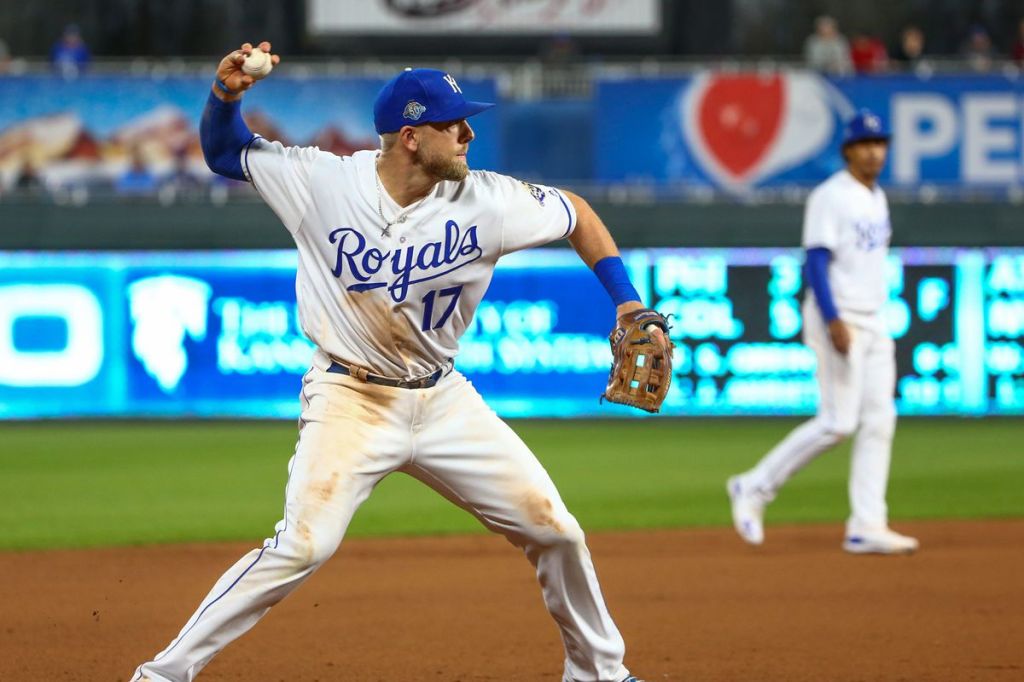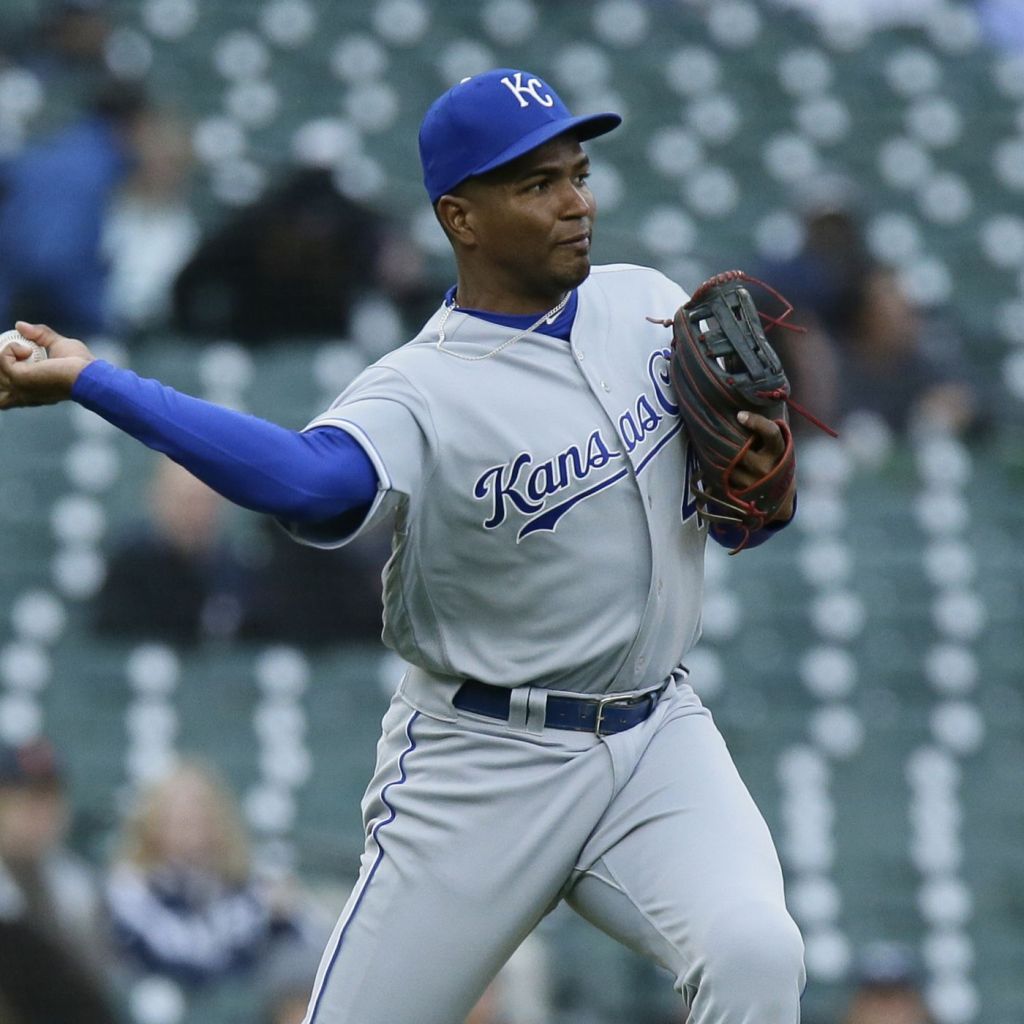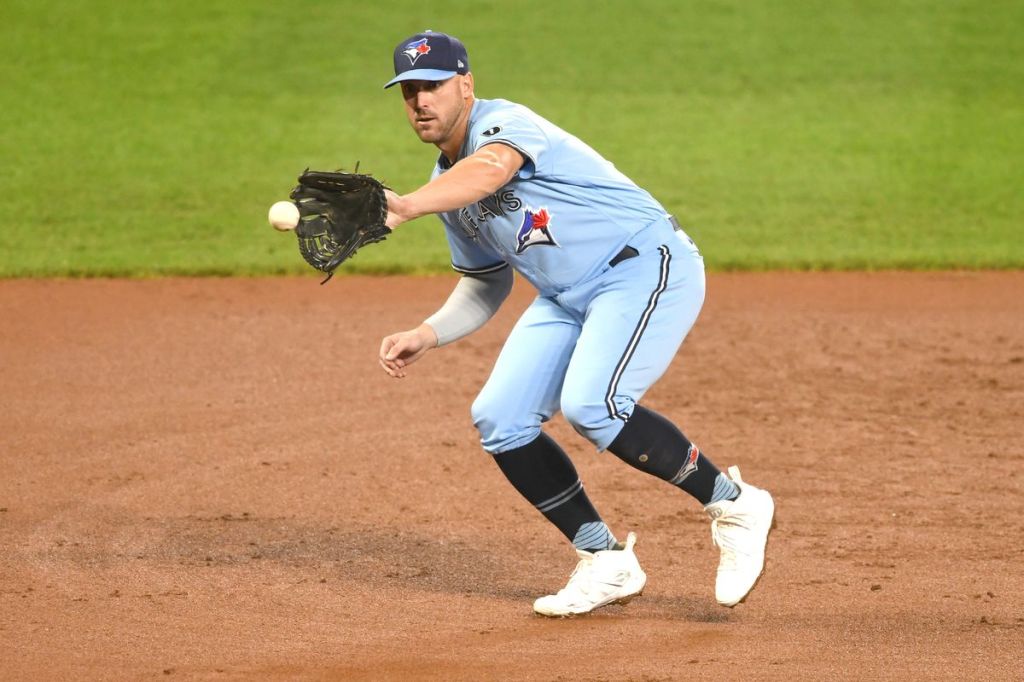There is no question the shadow of George Brett looms large over the third base position in Kansas City. From 1994-2020, only two Royals who have manned the third base position in Kansas City have accumulated a WAR of over 10, according to Fangraphs: Joe Randa (13.2 fWAR) and Mike Moustakas (12.6 fWAR). Furthermore, only six total Royals third basemen have garnered 1,000 or more plate appearances at the hot corner since 1994. That list includes not only Randa (4,158 PA) and Moose (3,735 PA), but also Mark Teahan (2,732 PA; 3.7 fWAR), Alberto Callaspo (1,241 PA; 3.9 fWAR), Hunter Dozier (1,181 PA; 2.9 fWAR), and Cheslor Cuthbert (1,160 PA; -1.0 fWAR).
Safe to say, with only a couple of exceptions, things have been lean at third base since Brett hung up the cleats for good after the 1993 season. The Royals did get a promising 60-gam campaign from free-agent signing Maikel Franco, but like many options who came after Brett, Franco was not deemed a long-term option in Kansas City, and was non-tendered this off-season.
According to the Royals depth chart on Roster Resource, Dozier is projected to be back at third base in 2021, after mostly playing the outfield and first base last year. The free agent signing of Carlos Santana pushes him off of first base, and even though the outfield picture is still incomplete (as of now, Roster Resource projects Francy Cordero, Michael A. Taylor, and Whit Merrifield to be the starting outfield), it doesn’t seem likely that Dozier fits there, especially since he has been mediocre defensively in the outfield over his career.
Nonetheless, though he has certainly demonstrated that he can hit at the Major League level, his future seems shaky at the hot corner, especially on a long-term basis. This reputation stems not only from his questionable defensive play (Franco was deemed a better option than him at third, which says something considering Franco’s defensive history), but also due to the emergence of Kelvin Gutierrez in Winter League play, and Bobby Witt, Jr. at the Alternate Site this past summer. In addition, it’s not out of the question to think that Dayton Moore and the Royals will be in play for a utility type who can play third base, as Travis Shaw and Jurickson Profar are popular names being thrown out there who could handle the hot corner position admirably, especially on the defensive end.
Hence, the Royals third base position could be the primary ‘position’ to watch this Winter and even in Spring Training.
Because honestly, it could give a glimpse of what the Royals will do at the position not just for 2021, but beyond as well.

As of now, Dozier appears to be in the driver’s seat when it comes to the Kansas City third base position in 2021. After all, Dozier has played 293 games at third over his Royals career, and he is not far removed from a 2019 campaign where he finished runner-up in All-Star voting to eventual third-base vote winner, Alex Bregman of the Houston Astros. If the Royals want to compete in the Central, then as of now, of the current options, Dozier seems to be the safest bet at third base for 2021.
That being said, at the surface, the idea of Dozier at third is not necessarily a bad one, especially considering his offensive impact at the position in 2019. In 139 games and 586 plate appearances in 2019, Dozier posted a wRC+ of 124 and a fWAR of 3.0, according to Fangraphs. The former Royals 2013 first-round pick showed a significant uptick in power in 2019, as he went from a .166 ISO (isolated slugging) during an uneven 102-game sample in 2018 to a .243 ISO in 2019. Additionally, he also added 26 home runs and had 84 RBI, and saw tremendous gains in plate discipline. His walk rate improved from 6.2 percent in 2018 to 9.4 percent in 2019, and his strikeout rate dropped from 28.1 percent in 2018 to 25.3 percent in 2019, which produced a BB/K ratio improvement from 0.22 in 2018 to 0.37 in 2019.
The improvement in these batting eye metrics seemed to stem from him not only swinging less at the plate, but also chasing less pitches outside the strike zone as well. Early on in his career, Dozier swung on pitches outside the strike zone 35.4 percent of the time in 2016 and 35.5 percent of the time in 2018. In 2019, that rate dropped to 30.1 percent, a remarkable 5.3 percent improvement. This improved ability to lay off bad pitches outside the zone also resulted in an approach that saw him swing less, as he went from swing rates of 51.2 percent in 2016 and 50.1 percent in 2018 to a swing rate of 44.7 percent in 2019. This approach paid off with Dozier’s breakout campaign two seasons ago, and there was hope that Dozier, who had developed slowly in the Royals system due to nagging injuries, would finally live up to his first-round prospect hype.
The Royals’ decision to move Dozier off the third base was far from the only thing that happened to Dozier in the 2020 off-season. Not only did he move initially to right field, but he also tested positive for COVID right before the season started up again, which delayed his start in the shortened season. When he did return, Dozier did showcase a continued improvement in plate discipline, as he not only continued to swing less at the plate (his swing rate was only 41.9 percent, a 2.9 percent regression from 2019), but he also continued to walk more as well (14.5 percent walk rate; 0.56 BB/K ratio).
Unfortunately, his power in 2020 resembled his 2018 sample rather than his 2019 one, as his ISO regressed to .165, and consequently, he only posted a 104 wRC+ in 2020, according to Fangraphs. Furthermore, his Statcast metrics from 2020 also showed significant regressions in power that may concern Royals fans. His exit velocity on batted balls regressed from 91.1 MPH to 86.4; his hard hit rate dropped from 42.9 percent to 30.9 percent; and his barrel rate went from 10.0 to 8.2 percent, all according to Baseball Savant. Yes, considering his slow start due to COVID and the shortened season, some regression was to be expected from 2019. That being said, his drops in many different power categories was a disheartening sign that will need to be monitored closely in 2021.
In addition to some power concerns, Dozier’s defense at third has been an adventure for the Royals, and it’s tough to think that Moore and even manager Mike Matheny would consider him a long-term fit at the position. According to Fangraphs defensive metrics, between 2018 and 2019 at third, he rated 14 runs BELOW average according to Defensive Runs Saved, and he also rated 8.1 runs BELOW average, according to UZR as well. According to Stacast’s outs above average (OAA), he was six outs BELOW average in 2018 and one out BELOW average in 2019. Based on these metrics, it seems likely that Dozier is not going to win any Gold Gloves at the hot corner anytime soon.
Thus, it’s not surprising that Gutierrez is gaining some momentum going into Spring Training, especially when taking Dozier’s metrics into consideration as well as Gutierrez’s impressive Winter Ball campaign in the Dominican Republic.

Much like Dozier, the 26-year-old Gutierrez has struggled to stay healthy since coming over to Kansas City from the Washington Nationals organization in 2018 in the Kelvin Herrera trade. Gutierrez put up a promising .287/.367/.427 line in 75 games in Triple-A Omaha in 2019 and appeared in 20 games with the Royals that season as well. Unfortunately, he didn’t really impress at the plate, posting a 72 wRC+ in 79 plate appearances, and he also broke his toe in early August, which put him out for the rest of 2019. Injuries struck Gutierrez again this past Summer, as he sprained his elbow in mid-July during Summer Camp, and only played 4 games in 2020. Thus, before the Royals non-tendered Franco, it wasn’t crazy to think that Gutierrez was a non-tender candidate himself this Winter.
However, Gutierrez survived the chopping block, and seems to have put himself in position to be a dark horse competitor at third base this Spring, thanks to his strong performance in the Dominican Winter League (LIDOM). In 17 games, Gutierrez has been the Gigantes del Cibao’s best hitter, posting a .396/.492/.604 slash line with a 1.096 OPS, two home runs and a 0.67 BB/K ratio in 63 plate appearances. Furthermore, he has helped Gigantes not only tie for first in the division with a 16-14 record in LIDOM play, but he also has been a crucial piece to Gigantes making it to the LIDOM Series Finals as well.
As a prospect, Gutierrez has been known more for his glove and rocket arm than his bat, as he has not really tapped into his power, even in the Minors (he has never posted an ISO above .152, and that was in a 10-game rehab stint in Rookie League play). MLB Pipeline, who rated him as the Royals’ 24th best prospect in their most recent rankings, argued that while he had the natural strength to hit for power, his groundball-inducing swing sapped his potential. Here is what they said about Gutierrez in their scouting report:
Gutierrez has shown that he can hit at every stage of his career. A right-handed hitter, he has excellent bat-to-ball skills and a knack for making hard contact to all fields but doesn’t consistently drive the ball in the air. After producing a 55.2 percent ground-ball rate across full-season levels (dating back to 2016), he hit the ball on the ground 68 percent of the time with the Royals in 2019. Gutierrez is a physically strong player whom the Royals believe will hit for power once he learns to catch the ball more out in front.
Gutierrez will have to develop at least some usable game power to profile as a big league third baseman. Though he’s an above-average defender with a plus arm and the contact skills to be serviceable there, he’s unlikely to break through as an everyday player without an uptick in power.
“No. 24: Kelvin Gutierrez” Royals Top 30 Prospects; MLB Pipeline
Are Royals fans seeing that launch angle adjustment from Gutierrez? His -1.8 and 6.1 launch angle the past two years, according to Baseball Savant, seem to confirm Pipeline’s concerns. However, in Winter League play, the Dominican-born corner infielder has showed the kind of launch in his swing that has not only produced a multitude of runs in LIDOM competition, but also shows the potential Gutierrez could bring to the third base position in 2021 and beyond, if he can transition that swing to Kansas City. Even when he’s not hitting bombs, Gutierrez is displaying a propensity for line drives, even in the Final Series, as evidenced in the Tweet below:
Of course, he has been doing this against LIDOM, not MLB pitching. Therefore, can Gutierrez transition this newfound power and hitting to Spring Training in Surprise, and if so, could that help him overtake Dozier at some point in 2021 for the third base position?

That being said, Gutierrez may not be the only competition Dozier will face this upcoming Spring. It is possible that Moore could sign a third-base option in free agency, as there are many cheap, short-term options that could thrive in Kansas City in 2021, much like Franco a season ago. In addition to Profar, who not only could play the outfield, but could also play third base as well, other free agent options could include the following players below, who could come to Kansas City on 1-2 year deals with AAV figures in between $3-8 million, which would be perfectly within the Royals’ price range:
- Travis Shaw: The 30-year-old former Blue Jay and Brewer has struggled the past two seasons (-0.6 fWAR in 2019 and 2020 combined), but he did have 3.5 and 3.6 WAR seasons in 2017 and 2018, respectively in Milwaukee. Shaw is decent defensively, as he has put up positive Def ratings in the Majors since debuting with the Red Sox in 2015. He may be on the downside of the career, and could cater in Kansas City, but he is a left-handed bat with 30-home run upside.
- Brad Miller: The 31-year-old former Cardinal is a poor man’s Shaw of sorts, but unlike Shaw, he is coming of a strong season in St. Louis in 2020. Miller won’t hit for a high average (.232 average a year ago), and defensively, he may be around Dozier’s level (4.6 runs below average according to Fangraphs’ Def rating last year). However, his ability to get on base and hit for power make him a potential “Franco-esque” signing in 2021.
- Tommy La Stella: La Stella may be the most expensive of the bunch, as Fangraphs is projecting a two-year $14 million deal for him this off-season. After being more of a “contact” hitter during his early Cubs years, La Stella grew in his power in Anaheim, hitting 16 home runs and posting a .192 ISO in 2019 in only 80 games with the Angels in 2019. Last year, his ISO remained stable at .168, and he walked more than he struck out, a skill that would be highly coveted by this Royals lineup. Lastly, La Stella would have some utility in the infield, as he could play second or shortstop in a pinch, though third would probably fit him best defensively.
Dozier certainly has the inside track on the third-base position, but it won’t be a sure deal for him in 2021. With Witt Jr. looking to be ready sooner than expected, it is possible that Dozier could be in his final season at the hot corner next year, and that is if the Royals do not acquire a third baseman via free agency, or if Gutierrez doesn’t challenge him for the spot. Even though he had an impressive Summer Camp in 2020, it seems unlikely that Witt will start 2021 in Kansas City. However, if he impresses in Double-A as expected, he could make the 40-man roster by season’s end, which in turn could result in a September call up. And if that happens, it would make logical sense that Witt would be at third base in Kansas City, unless Dozier is channeling his 2019 self in 2021.
The Royals are certainly at a weird crossroads with Dozier. He doesn’t have a position really, and while his plate discipline has improved, his regression in power was concerning and could leave things open for a potential free agent or Gutierrez to perhaps take his spot, which seemed unthinkable two seasons ago. If the Royals do want to make a dark horse run in the Central Division, they will need not only a healthy Dozier, but a productive one as well, especially at the plate.
The main question is this: will Dozier be doing it at third or somewhere else in 2021?
Spring training in Surprise certainly could be more of a challenge for the third base position than expected for the “Bull-Dozier.” Furthermore, that challenge could amplify in the coming weeks if Moore pulls the trigger on a free agent, which seems likely, though who the free agent will be seems to still be up in the air.
That being said, after a rough 2018, Dozier entered 2019 with the same dubious expectations…and Royals fans know how that turned out for him and the Royals.
Let’s see if he can do that again in 2021…

[…] O’Brien de Royals Reporter cree que Hunter Dozier podría tener algo de competencia en la tercera de Kelvin […]
LikeLiked by 1 person
[…] With the hot stove finally heating up, the baseball world has seen a slew of recent transaction activity, even in the midst of tragedy (RIP Hank Aaron). However, on Friday, the Royals got a bit of bad news in regard to Jurickson Profar, a utility player that the Royals were seemingly in talks with earlier this Winter: […]
LikeLiked by 1 person
[…] glove didn’t seem to wow the Royals front office in 2019 (hence, the Franco move) and even Mike Matheny seemed more apt to put Dozier at first not just in 2020, but in 2021 until the Royals acquired Carlos Santana. Thus, while Dozier’s […]
LikeLiked by 1 person
[…] now, Dozier is the guy at third, and it makes the most sense since the Royals don’t necessarily have an immediate option at […]
LikeLiked by 1 person
[…] Granted, Dozier continues to be an enigma in the field, which has been the case for him for most of his career. […]
LikeLike
[…] those days off. It would be better for Eaton to be that option rather than Dozier, who’s been historically terrible at third, or Lopez, who would be better off coming off the bench and relieving Witt or Massey in the middle […]
LikeLike